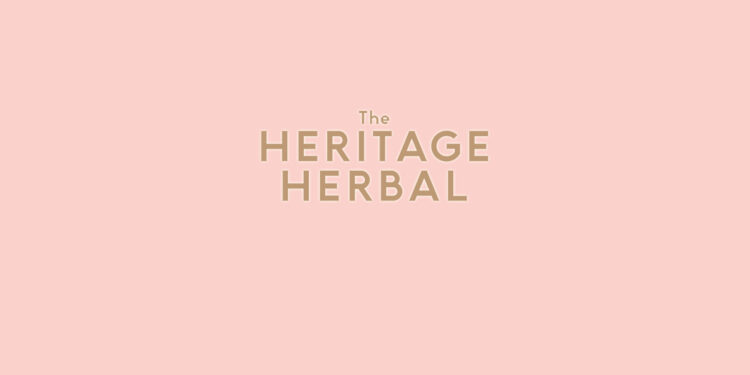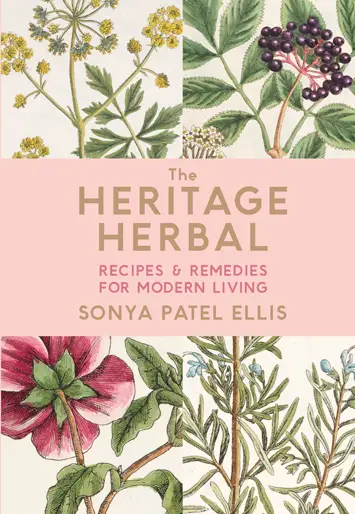The Heritage Herbal: Recipes And Remedies For Modern Living by Sonya Patel Ellis – Review

By Elizabeth Stanforth-Sharpe
Sonya Patel Ellis has been an established author, writer and publisher, focusing on plants, gardening and horticulture for over 25 years, well known for exploring the botanical world in relation to its interconnectivity with science, the arts, history and well-being, but the blurb for The Heritage Herbal – Recipes And Remedies For Modern Living tells the reader that it is, “a deep dive into the history of herbals, heritage herbs, modern recipes and remedies to heal, nourish and style”, and it is a claim that I struggle to agree with.
It is certainly an aesthetically beautiful book, and it gets off to a promising start. Ellis devotes the introductory chapters to a historical overview of the collection and recording of herbs, beginning with Elizabeth Blackwell’s, ‘A Curious Herbal’ (1737-1739), written, in part, to secure her husband’s release from debtor’s prison, and then marching through the centuries to encompass the works of William Woodville, James Sowerby, Sir Joseph Banks, Carl Linnaeus, Mrs M Grieve, Hilda Leyel and Nicholas Culpeper; useful to readers who may be new to the use of herbs, and providing excellent pointers to a number of avenues for further investigation.
Elizabeth Blackwell was a talented botanical artist in addition to being a herbalist. The British Library has made a small number of her plates available for viewing via their ‘Turning The Pages’ technology, but Ellis has scattered a far greater number through the pages of The Heritage Herbal; a gesture that makes her book stunning to hold for both art-lovers and plant aficionados. The traditional formatting for cataloguing herbals has been by ‘Identifying, Time and Place of where the specimen can be gathered, Preparation, and Uses’. Ellis has put her focus on just 35 selected herbs, organised in alphabetical order and, in a modern twist of the classical listings, has utilised the headings, ‘Heal’, ‘Nourish’ and ‘Style’ for each individual plant. There is an additional section of useful advice that is pertinent to all, such as foraging, storing, and how to make infusions, decoctions and syrups.
Occasionally, Ellis drops enticing quotes, historical or folklore snatches into the narrative in such a way that the reader wants to know more, but they are the faintest wisps, like butterflies alighting momentarily on open petals, then fluttering away before close inspection can be made. These are interesting snapshot indications that there is much more on this subject to be explored than is between the covers of this book, but they are not a ‘deep dive’ in themselves – and I would suggest that Ellis’ target readers will be all the more comforted by that.
“A resurgence of interest”
 The ’Heal’ and ‘Nourish’ sections for each herb are reasonably conventional, and in line with other basic herbal listings, but with a few surprising imaginings thrown in. The medicinal properties of plants have been known since time began, form the principles and ingredients of many important pharmaceutical preparations, and have a great deal to teach us about the remarkable capacity that nature holds to heal and restore our physical, mental and emotional well-being; it is a lore that was becoming lost to all but a few but, post-pandemic, a resurgence of interest is emerging, and this is where Ellis’ The Heritage Herbalist is to be truly applauded – not as a ‘deep dive’, but as a graceful introduction for those whose curiosity is spiked, and who may feel overwhelmed by a meatier tome.
The ’Heal’ and ‘Nourish’ sections for each herb are reasonably conventional, and in line with other basic herbal listings, but with a few surprising imaginings thrown in. The medicinal properties of plants have been known since time began, form the principles and ingredients of many important pharmaceutical preparations, and have a great deal to teach us about the remarkable capacity that nature holds to heal and restore our physical, mental and emotional well-being; it is a lore that was becoming lost to all but a few but, post-pandemic, a resurgence of interest is emerging, and this is where Ellis’ The Heritage Herbalist is to be truly applauded – not as a ‘deep dive’, but as a graceful introduction for those whose curiosity is spiked, and who may feel overwhelmed by a meatier tome.
Ellis includes instructions to address most household first-aid and beauty needs. Immunity building teas, decongestants, salves for insect bites, burns and small cuts, foot soaks, lip-balms, vitamin tonics, cough syrups, styptic poultices, tinctures for menopausal hot flushes, massage oils for sore muscles, remedies for puffy eyes, and conditioning hair rinses, are all there. Enough for whetting an appetite of experimentation, without over complicating things.
The ‘Nourish’ section has delicious sounding ways of introducing the named plants into dishes, and there are some recipes I will try, but, as someone whose son picks every last scraping of mint out of a dish of new potatoes and eyes with suspicion parsley garnishes or crystallised flowers, I’m always slightly in awe of those domestic goddesses who get away with serving up Marigold petals on their pizzas, proffer nettle quiches with a side helping of dandelions, breakfast on Earth-Apple porridge, and advocate chewing on a brush fashioned from a liquorice root for perfectly cleansed teeth, ‘though I am tempted to sneak a pot of Angelica jam on to the table, and Sweet Violet syrup drizzled over ice-cream sounds delightful.
The ’Style’ section is a heady mixture of the enchanting and surreal. It implies that a bright green Georgian Tarkhun – sort of like a tarragon soft drink – would be just the thing to serve at a children’s birthday party, whilst the adults relax on the chamomile lawn, sipping on Burnet gimlet cocktails, before spending the evening whipping up a love potion, relaxing in a Hyssop ritual bath, and lying on linen sheets sprayed with Sweet Violet perfume. It all sounds very decadent, may happen on celebrity Instagrams, and may, for all I know, be reality for the author, but I don’t think I’m alone in finding it a little unrelatable. For those of us too pragmatically Yorkshire to wander around in a coronet woven from daisies in order to attract lovers, and those of us with gardens too small to create a mediaeval knot garden, it’s a part of the book perhaps best read with a large pinch of salt (“Himalayan and pink, of course, da…h…ling”). That said, it is a gorgeous smorgasbord of inspiration, which can be simplified and drawn upon to joosh up a special occasion, or to make an unusual gift, and I’m definitely going to try the Johnny-Jump-Up ices, for no other reason than that they sound so pretty to look at.
Ellis’ blurb writer may have had every good intention, but I feel that they did the author a disservice. The Heritage Herbal isn’t a ‘deep dive’ in any sense of the phrase, BUT it is no less of an interesting work for that. It is a sound, introductory overview of the history of herbals and the ways that herbs can be used. It gives resources for those want to take their explorations further, provides enough information to build confidence in making basic preparations, and Elizabeth Blackwell’s exquisite etchings placed on every page make the book one I will reach for again.
‘The Heritage Herbal: Recipes And Remedies For Modern Living’ by Sonya Patel Ellis is published by The British Library









